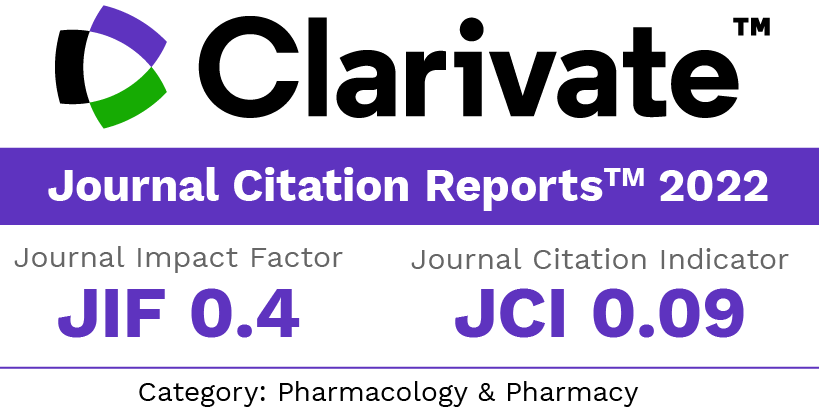La polifarmacia como un factor de riesgo para síntomas depresivos en pacientes geriátricos: un estudio observacional transversal
DOI:
https://doi.org/10.30827/ars.v57i3.5330Palabras clave:
adulto mayor, efectos adversos de la droga, salud mental, psiquiatríaResumen
Objetivo: El objetivo de este estudio es investigar la correlación entre la polifarmacia y los síntomas depresivos en adultos hospitalizados mayores de 65 años.
Pacientes y métodos: Se obtuvo la historia clínica y los datos actuales de tratamiento de las historias clínicas. Se utilizó la puntuación de la prueba Mental Abreviado (AMTS) para excluir a los pacientes con demencia. La Escala de Depresión Geriátrica (GDS) se utilizó para evaluar los síntomas depresivos. Se usaron coeficientes Pearson y Spearman para determinar la relación entre las variables.
Resultados: Se incluyó a un total de 206 individuos. El número medio de medicamentos tomados por los individuos fue de 6,9 ± 2,7 y la puntuación media GDS fue de 4,9 ± 3,4 puntos. Los síntomas de depresión (GDS puntuación> 5 puntos) se observaron en 68 (33,0%) individuos. La puntuación GDS de una correlación positiva con el número de medicamentos que se usaron (R = 0,74; P = 0,0001), el número de condiciones crónicas (R = 0,78; P = 0,001), y quejas de dolor (Z = 7,94; P = 0,0001). Se observó una asociación significativa entre la partitura GDS y el uso de los siguientes medicamentos: estatinas, agentes citostáticos, corticoesteroides, benzodiazepinas, glucósidos cardíacos, los fármacos no esteroides antiinflamatorios, relajantes musculares, medicamentos sin psicotrópicas con propiedades anticolinérgicas, y de acción central analgésicos (todos P <0,05).
Conclusiones: Nuestro estudio indica que la polifarmacia se correlaciona positivamente con la presencia de síntomas depresivos en pacientes geriátricos. Se identificó una serie de medicamentos asociados con una mayor prevalencia de síntomas depresivos; Sin embargo, estas relaciones requieren un examen más detenido.
Descargas
Citas
European Commission; Directorate General for Economic and Financial Affairs. The 2015 Ageing Report: Underlying Assumptions and Projection Methodologies. European Economy. 2014.
Barua A, Ghosh MK, Kar N, Basilio MA. Prevalence of depressive disorders in the elderly. Ann Saudi Med. 2011;31(6):620-624.
Royal College of Psychiatrists; Faculty of Old Age. Who Cares Wins. Improving the outcome for older people admitted to the general hospital: guidelines for the development of liaison mental health services for older people. London. 2005.
Wiese BS. Geriatric depression: The use of antidepressants in the elderly. BCMJ. 2011;53:341-347.
Parker C. Psychiatric effects of drugs for other disorders. Medicine. 2012;40(12):691-695.
Hodkinson HM. Evaluation of a mental test score for assessment of mental impairment in the elderly. 1972. Age Ageing. 2012;41 Suppl 3:iii35-40.
Sheikh J, Yesavage J. Geriatric Depression Scale: recent evidence and development of a shorter version. Clin Gerontol. 1986;5:165-173.
Liu CP, Leung DS, Chi I. Social functioning, polypharmacy and depression in older Chinese primary care patients. Aging Ment Health. 2011;15(6):732-741.
Antonelli Incalzi R, Corsonello A, Pedone C, Corica F, Carbonin P. Depression and drug utilization in an elderly population. Ther Clin Risk Manag. 2005;1:55-60.
Maher RL, Hanlon J, Hajjar ER. Clinical consequences of polypharmacy in elderly. Expert Opin Drug Saf. 2014;13(1):57-65.
Qato DM, Alexander GC, Conti RM, Johnson M, Schumm P, Lindau ST. Use of prescription and over-the-counter medications and dietary supplements among older adults in the United States. JAMA. 2008;300(24):2867-2878.
Nobili A, Licata G, Salerno F, et al.. Polypharmacy, length of hospital stay, and in-hospital mortality among elderly patients in internal medicine wards. The REPOSI study. Eur J Clin Pharmacol. 2011;67(5):507-519.
Gallagher P, Lang PO, Cherubini A, et al.. Prevalence of potentially inappropriate prescribing in an acutely ill population of older patients admitted to six European hospitals. Eur J Clin Pharmacol. 2011;67(11):1175-1188.
Marengoni A, Angleman S, Melis R, et al.. Aging with multimorbidity: a systematic review of the literature. Ageing Res Rev. 2011;10(4):430-439.
Spangenberg L, Forkmann T, Brahler E, Glaesmer H. The association of depression and multimorbidity in the elderly: implications for the assessment of depression. Psychogeriatrics. 2011;11(4):227-234.
Marazziti D, Mungai F, Vivarelli L, Presta S, Dell’Osso B. Pain and psychiatry: a critical analysis and pharmacological review. Clin Pract Epidemiol Ment Health. 2006;2:31.
Banks SM, Kerns RD. Explaining high rates of depression in chronic pain: A diathesis-stress framework. Psychol Bull 1996;119:95-110.
Abdulraheem IS. Polypharmacy: A Risk Factor for Geriatric Syndrome, Morbidity & Mortality. Aging Sci. 2013;1.
Nobili A, Pasina L, Tettamanti M, et al.. Potentially severe drug interactions in elderly outpatients: results of an observational study of an administrative prescription database. J Clin Pharm Ther. 2009;34(4):377-386.
Pirmohamed M, James S, Meakin S, et al.. Adverse drug reactions as cause of admission to hospital: prospective analysis of 18 820 patients. BMJ. 2004;329(7456):15-19.
Bourgeois FT, Shannon MW, Valim C, Mandl KD. Adverse drug events in the outpatient setting: an 11-year national analysis. Pharmacoepidemiol Drug Saf. 2010;19(9):901-910.
Fulton MM, Allen ER. Polypharmacy in the elderly: a literature review. J Am Acad Nurse Pract. 2005;17(4):123-132.
Nobili A, Garattini S, Mannucci PM. Multiple diseases and polypharmacy in the elderly: challenges for the internist of the third millennium. J Comorbidity. 2011;1:28-44.
Turjansk N, Lloyd GG. Psychiatric side-effects of medications: recent developments. . Adv Psychiatr Treat. 2011;11:58-70.
Pasina L, Djade CD, Lucca U, et al.. Association of anticholinergic burden with cognitive and functional status in a cohort of hospitalized elderly: comparison of the anticholinergic cognitive burden scale and anticholinergic risk scale: results from the REPOSI study. Drugs Aging. 2013;30(2):103-112.
Drevets WC, Zarate CA, Jr., Furey ML. Antidepressant effects of the muscarinic cholinergic receptor antagonist scopolamine: a review. Biol Psychiatry. 2013;73(12):1156-1163.
Cheng JW, Rybak I. Use of digoxin for heart failure and atrial fibrillation in elderly patients. Am J Geriatr Pharmacother. 2010;8(5):419-427.
Celano CM, Freudenreich O, Fernandez-Robles C, Stern TA, Caro MA, Huffman JC. Depressogenic effects of medications: a review. Dialogues Clin Neurosci. 2011;13(1):109-125.
Rutledge T, Reis VA, Linke SE, Greenberg BH, Mills PJ. Depression in heart failure a meta-analytic review of prevalence, intervention effects, and associations with clinical outcomes. J Am Coll Cardiol. 2006;48(8):1527-1537.
Warrington TP, Bostwick JM. Psychiatric adverse effects of corticosteroids. Mayo Clin Proc. 2006;81(10):1361-1367.
Kenna HA, Poon AW, de los Angeles CP, Koran LM. Psychiatric complications of treatment with corticosteroids: review with case report. Psychiatry Clin Neurosci. 2011;65(6):549-560.
Yang M, Moon C. Neurotoxicity of cancer chemotherapy. Neural Regen Res. 2013;8(17):1606-1614.
van Vliet P, van der Mast RC, van den Broek M, Westendorp RG, de Craen AJ. Use of benzodiazepines, depressive symptoms and cognitive function in old age. Int J Geriatr Psychiatry. 2009;24(5):500-508.
Sithamparanathan K, Sadera A, Leung L. Adverse effects of benzodiazepine use in elderly people: a meta-analysis. Int J Geriatr Psychiatry. 2012;7:107-111.
Swiger KJ, Manalac RJ, Blaha MJ, Blumenthal RS, Martin SS. Statins, mood, sleep, and physical function: a systematic review. Eur J Clin Pharmacol. 2014;70(12):1413-1422.
Ainiyet B, Rybakowski JK. Suicidal behaviour and lipid levels in unipolar and bipolar depression. Acta Neuropsychiatr. 2014;26(5):315-320.
Tatley M, Savage R. Psychiatric adverse reactions with statins, fibrates and ezetimibe: implications for the use of lipid-lowering agents. Drug Saf. 2007;30:195-201.
Descargas
Publicado
Cómo citar
Número
Sección
Licencia
Los artículos que se publican en esta revista están sujetos a los siguientes términos en relación a los derechos patrimoniales o de explotación:
- Los autores/as conservarán sus derechos de autor y garantizarán a la revista el derecho de primera publicación de su obra, la cual se distribuirá con una licencia Creative Commons BY-NC-SA 4.0 que permite a terceros reutilizar la obra siempre que se indique su autor, se cite la fuente original y no se haga un uso comercial de la misma.
- Los autores/as podrán adoptar otros acuerdos de licencia no exclusiva de distribución de la versión de la obra publicada (p. ej.: depositarla en un archivo telemático institucional o publicarla en un volumen monográfico) siempre que se indique la fuente original de su publicación.
- Se permite y recomienda a los autores/as difundir su obra a través de Internet (p. ej.: en repositorios institucionales o en su página web) antes y durante el proceso de envío, lo cual puede producir intercambios interesantes y aumentar las citas de la obra publicada. (Véase El efecto del acceso abierto).
























